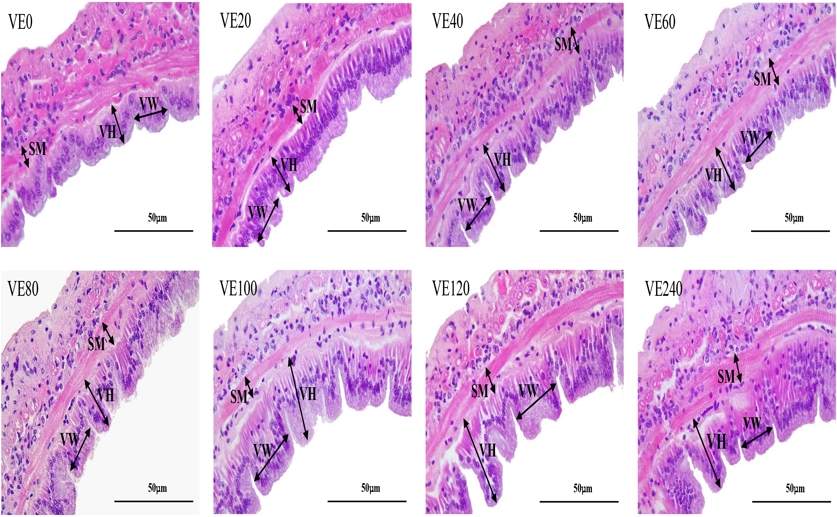Jenn Hoskins
1st October, 2025

Microscope images of shrimp intestines from the study reveal that VE80, showing increased villi height (VH), represents an optimal addition of vitamin E compared to no Vitamin E (VE0).
Key Findings
- This study, conducted on juvenile Pacific white shrimp, determined the ideal amount of Vitamin E for optimal health
- Shrimp grew best and showed strongest immune responses when fed a diet with around 80 mg/kg of Vitamin E
- Adequate Vitamin E (80-120 mg/kg) significantly improved shrimp’s resistance to infection from the harmful bacterium Vibrio parahaemolyticus
The study[1] focused on determining the optimal dietary Vitamin E requirement for shrimp growth, feed efficiency, immune function, antioxidant capacity, digestive health, and resistance to the harmful bacterium Vibrio parahaemolyticus. Eight different diets were created, each containing varying levels of Vitamin E – from none at all (0 mg/kg) up to 240 mg/kg. Shrimp were fed these diets for 56 days, and their performance was carefully monitored.
The results showed that shrimp fed a diet with 80 mg/kg of Vitamin E exhibited the best growth compared to those receiving either too little (0 or 20 mg/kg) or too much (240 mg/kg) Vitamin E. This suggests there’s a sweet spot for optimal benefit. Interestingly, immune responses were strongest in shrimp receiving between 60-80 mg/kg, indicating that Vitamin E plays a key role in bolstering the shrimp’s defenses.
This finding aligns with earlier research highlighting the importance of adequate nutrition in mitigating stress in aquaculture[2]. Crowded conditions increase disease susceptibility, and supplementing diets with nutrients beyond basic requirements can improve health and disease resistance. The study demonstrated this directly by observing reduced lipid peroxidation – a sign of cellular damage caused by oxidative stress – in the livers of shrimp fed the 80 mg/kg diet.
Further analysis revealed that specific genes involved in the shrimp’s immune system ( Crustin, C-MnSOD, and GPx ) were more active in the shrimp receiving 80 mg/kg Vitamin E. This suggests that Vitamin E isn’t just preventing damage; it’s actively strengthening the shrimp’s ability to fight off infection. Vitamin E’s antioxidant properties, stemming from its ability to donate hydrogen to damaging molecules, are well-documented in livestock[3], and this study extends that understanding to shrimp.
The benefits weren’t limited to immunity. Shrimp fed the 80 mg/kg diet also digested protein, lipids (fats), and dry matter more efficiently, and their intestinal structure – specifically the height and width of villi (small finger-like projections that absorb nutrients) – was improved. This indicates that Vitamin E contributes to better overall digestive health.
Perhaps most importantly, shrimp fed diets containing 80-120 mg/kg Vitamin E were significantly more resistant to infection by Vibrio parahaemolyticus. This bacterium is a major threat in shrimp farming, often linked to acute hepatopancreatic necrosis disease (AHPND), a devastating condition causing high mortality rates. The researchers used broken-line analysis to pinpoint the optimal dietary Vitamin E level at approximately 72.17 mg/kg for weight gain and 72.21 mg/kg for specific growth rate.
This research builds upon previous understandings of Vitamin E’s cellular effects[4], which include influencing gene expression related to blood coagulation and inflammation. The study provides practical evidence for the benefits of Vitamin E supplementation in shrimp, potentially reducing the risk of AHPND and improving overall farm productivity.
References
Main Study
1) Effects of dietary vitamin E on growth, immune response, antioxidant capacity, intestinal histomorphology, digestibility and disease resistance of juvenile Pacific white shrimp (Penaeus vannamei)
Published 30th September, 2025
https://doi.org/10.1371/journal.pone.0333473
Related Studies
Related Articles

